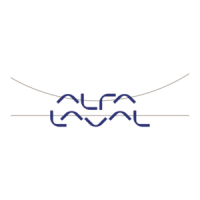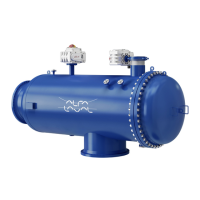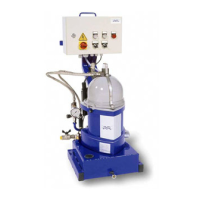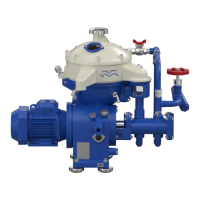Do you have a question about the Alfa Laval S 821 and is the answer not in the manual?
Outlines key safety warnings and their importance.
Explains the purpose and principles of separation.
Describes the overall design and functionality of the separator.
Provides guidance for operating the separator.
Details hazards associated with high-speed rotating parts.
Lists fundamental safety guidelines for operation and maintenance.
Warns about risks like incorrect rotation, vibration, and material fatigue.
Covers hazards from entrapment, electricity, and crushing during operation.
Details hazards related to noise, burns, and skin irritation.
Addresses hazards from cuts, flying objects, and unhealthy dust.
Defines DANGER, WARNING, CAUTION, and NOTE signs used in the manual.
Provides guidance on proper disposal of packing and maintenance materials.
Specifies qualifications for operators and maintenance staff.
Explains separation principles based on gravity in a stationary state.
Describes centrifugal force and the influence of temperature on separation.
Details the process section, frame feet, drive section, motor, and lubrication.
Describes sensors for monitoring and the sludge discharge mechanism.
Provides a general description of the separator's main components and functions.
Details the belt transmission and centrifugal clutch mechanism.
Explains how the separation process occurs within the bowl.
Details the construction and components of the separator bowl.
Describes the speed sensor and optional unbalance/interlocking sensors.
Explains separation and liquid distribution within the bowl.
Describes liquid path, sludge removal, and ALCAP™ water removal.
Guides on initial preparation before the separator's first operation.
Advises on checks before starting after maintenance or for normal operation.
Provides step-by-step instructions for starting the separator.
Lists critical checks to perform while the separator is running.
Details the procedure for performing sludge discharge while running.
Provides instructions for safely stopping the separator.
Outlines procedures for immediate shutdown in emergencies.
Explains preventive maintenance importance and schedules.
Outlines general steps for performing inspections and overhauls.
Details kits, torque values, and cleaning procedures including CIP.
A log table for tracking inspection, overhaul, and check activities.
General introduction and safety notes for dismantling, lists required tools.
Details the procedure for removing the frame hood.
Lists components and tools for bowl dismantling.
Details the components and disassembly of the driving mechanism.
Steps for removing clutch cover, draining oil, and loosening belt.
Instructions for removing motor, water cover, bearing cover, and deflector ring.
Prepares for spindle removal and details fan, bearing, and housing removal.
Instructions for removing ball bearing, labyrinth ring, and bottom bearing holder.
Overview of the centrifugal clutch components and their disassembly.
Steps to remove and dismantle the coupling from the motor.
Procedures for cleaning separator parts before assembly.
Guidelines for inspecting parts for corrosion damage.
Procedures for checking separator parts for cracks.
Instructions for inspecting parts for erosion damage.
Details on how to replace the separator's frame feet.
Specifies lubrication points and lubricants for bowl components.
Instructions for applying slide lacquer to bowl parts.
Guides on checking for galling on critical sliding surfaces.
Step-by-step guide for assembling the centrifugal clutch.
Details on fitting the friction blocks and cover.
Instructions for installing the motor onto the separator.
Steps for installing and tensioning the flat belt.
Instructions for fitting the clutch cover.
Details on fitting the bottom bearing holder.
Instructions for fitting the labyrinth ring.
Steps for fitting the ball bearing to the top bearing seat.
Instructions for fitting the top bearing seat onto the spindle.
Details on fitting the top bearing housing.
Instructions for fitting spindle pulley and roller bearing.
Instructions for fitting the oil pump.
Details on fitting the fan and air deflector.
Steps for lowering the spindle assembly into the frame.
Instructions for fitting the neck bearing cover and deflector ring.
Details on fitting water cover and measuring spindle radial wobble.
Instructions for fitting clutch cover and filling the oil sump.
Procedures for checking bowl for damage and fitting valve plugs.
Instructions for fitting the operating slide and its holder.
Steps for fitting the operating water ring.
Instructions for lifting the bowl body onto the spindle.
Steps for fitting and tightening the cap nut.
Instructions for fitting the discharge slide.
Procedure for assembling the disc stack.
Instructions for fitting the disc stack assembly into the bowl body.
Details on assembling paring tube, holder, and inlet/outlet pipe.
Steps for fitting the top disc.
Instructions for fitting the bowl hood.
Steps for fitting the lock ring.
Procedure for checking and adjusting disc stack pressure.
Instructions for fitting the frame hood.
Procedure for measuring and adjusting paring disc height.
Steps for fitting the spring and arm.
Instructions for fitting the connection housing.
Details on fitting the unbalance sensor holder.
Procedure for adjusting the unbalance sensor.
Instructions for adjusting the speed sensor.
Checks for correct attachment of plates and labels.
Verifies that text on labels is readable and correct.
Guidelines for selecting and handling lubricating oil.
Procedure for checking and changing the separator's oil.
Details lubrication points, lubricants, intervals, and oil brands.
Detailed instructions for safely lifting the entire separator.
Steps for safely lifting the separator bowl.
Discusses causes and corrective actions for separator vibration.
Troubleshooting for smell, noise, low, and high speed issues.
Addresses causes of excessive/insufficient starting power and time.
Troubleshooting for bowl opening, closing, and separation results.
Provides a general overview of the product and its standards.
Lists detailed technical specifications and operating parameters.
Details all external connections and their requirements.
Defines purpose, references, definitions, and goals for interface design.
Explains different operating modes like Stand Still, Starting, and Running.
Conditions for remote start and managing electrical/fluid connections.
Functionality of interlocking switch and inlet/outlet fluid connections.
Specifies critical requirements for operating water quality.
Provides dimensional and foundation drawings of the separator.
Shows electrical wiring and details electric motor specifications.
General introduction to installation specifications.
Guidelines for transporting the separator.
Recommendations for protecting and storing the separator.
Lists critical dimensions for installation planning.
Requirements for the service area and equipment.
Guidance on connecting to external systems and safety regulations.
Procedures for storing the separator when not in use.
Steps to take before restarting after storage.
Outlines key safety warnings and their importance.
Explains the purpose and principles of separation.
Describes the overall design and functionality of the separator.
Provides guidance for operating the separator.
Details hazards associated with high-speed rotating parts.
Lists fundamental safety guidelines for operation and maintenance.
Warns about risks like incorrect rotation, vibration, and material fatigue.
Covers hazards from entrapment, electricity, and crushing during operation.
Details hazards related to noise, burns, and skin irritation.
Addresses hazards from cuts, flying objects, and unhealthy dust.
Defines DANGER, WARNING, CAUTION, and NOTE signs used in the manual.
Provides guidance on proper disposal of packing and maintenance materials.
Specifies qualifications for operators and maintenance staff.
Explains separation principles based on gravity in a stationary state.
Describes centrifugal force and the influence of temperature on separation.
Details the process section, frame feet, drive section, motor, and lubrication.
Describes sensors for monitoring and the sludge discharge mechanism.
Provides a general description of the separator's main components and functions.
Details the belt transmission and centrifugal clutch mechanism.
Explains how the separation process occurs within the bowl.
Details the construction and components of the separator bowl.
Describes the speed sensor and optional unbalance/interlocking sensors.
Explains separation and liquid distribution within the bowl.
Describes liquid path, sludge removal, and ALCAP™ water removal.
Guides on initial preparation before the separator's first operation.
Advises on checks before starting after maintenance or for normal operation.
Provides step-by-step instructions for starting the separator.
Lists critical checks to perform while the separator is running.
Details the procedure for performing sludge discharge while running.
Provides instructions for safely stopping the separator.
Outlines procedures for immediate shutdown in emergencies.
Explains preventive maintenance importance and schedules.
Outlines general steps for performing inspections and overhauls.
Details kits, torque values, and cleaning procedures including CIP.
A log table for tracking inspection, overhaul, and check activities.
General introduction and safety notes for dismantling, lists required tools.
Details the procedure for removing the frame hood.
Lists components and tools for bowl dismantling.
Details the components and disassembly of the driving mechanism.
Steps for removing clutch cover, draining oil, and loosening belt.
Instructions for removing motor, water cover, bearing cover, and deflector ring.
Prepares for spindle removal and details fan, bearing, and housing removal.
Instructions for removing ball bearing, labyrinth ring, and bottom bearing holder.
Overview of the centrifugal clutch components and their disassembly.
Steps to remove and dismantle the coupling from the motor.
Procedures for cleaning separator parts before assembly.
Guidelines for inspecting parts for corrosion damage.
Procedures for checking separator parts for cracks.
Instructions for inspecting parts for erosion damage.
Details on how to replace the separator's frame feet.
Specifies lubrication points and lubricants for bowl components.
Instructions for applying slide lacquer to bowl parts.
Guides on checking for galling on critical sliding surfaces.
Step-by-step guide for assembling the centrifugal clutch.
Details on fitting the friction blocks and cover.
Instructions for installing the motor onto the separator.
Steps for installing and tensioning the flat belt.
Instructions for fitting the clutch cover.
Details on fitting the bottom bearing holder.
Instructions for fitting the labyrinth ring.
Steps for fitting the ball bearing to the top bearing seat.
Instructions for fitting the top bearing seat onto the spindle.
Details on fitting the top bearing housing.
Instructions for fitting spindle pulley and roller bearing.
Instructions for fitting the oil pump.
Details on fitting the fan and air deflector.
Steps for lowering the spindle assembly into the frame.
Instructions for fitting the neck bearing cover and deflector ring.
Details on fitting water cover and measuring spindle radial wobble.
Instructions for fitting clutch cover and filling the oil sump.
Procedures for checking bowl for damage and fitting valve plugs.
Instructions for fitting the operating slide and its holder.
Steps for fitting the operating water ring.
Instructions for lifting the bowl body onto the spindle.
Steps for fitting and tightening the cap nut.
Instructions for fitting the discharge slide.
Procedure for assembling the disc stack.
Instructions for fitting the disc stack assembly into the bowl body.
Details on assembling paring tube, holder, and inlet/outlet pipe.
Steps for fitting the top disc.
Instructions for fitting the bowl hood.
Steps for fitting the lock ring.
Procedure for checking and adjusting disc stack pressure.
Instructions for fitting the frame hood.
Procedure for measuring and adjusting paring disc height.
Steps for fitting the spring and arm.
Instructions for fitting the connection housing.
Details on fitting the unbalance sensor holder.
Procedure for adjusting the unbalance sensor.
Instructions for adjusting the speed sensor.
Checks for correct attachment of plates and labels.
Verifies that text on labels is readable and correct.
Guidelines for selecting and handling lubricating oil.
Procedure for checking and changing the separator's oil.
Details lubrication points, lubricants, intervals, and oil brands.
Detailed instructions for safely lifting the entire separator.
Steps for safely lifting the separator bowl.
Discusses causes and corrective actions for separator vibration.
Troubleshooting for smell, noise, low, and high speed issues.
Addresses causes of excessive/insufficient starting power and time.
Troubleshooting for bowl opening, closing, and separation results.
Provides a general overview of the product and its standards.
Lists detailed technical specifications and operating parameters.
Details all external connections and their requirements.
Defines purpose, references, definitions, and goals for interface design.
Explains different operating modes like Stand Still, Starting, and Running.
Conditions for remote start and managing electrical/fluid connections.
Functionality of interlocking switch and inlet/outlet fluid connections.
Specifies critical requirements for operating water quality.
Provides dimensional and foundation drawings of the separator.
Shows electrical wiring and details electric motor specifications.
General introduction to installation specifications.
Guidelines for transporting the separator.
Recommendations for protecting and storing the separator.
Lists critical dimensions for installation planning.
Requirements for the service area and equipment.
Guidance on connecting to external systems and safety regulations.
Procedures for storing the separator when not in use.
Steps to take before restarting after storage.
| Brand | Alfa Laval |
|---|---|
| Model | S 821 |
| Category | Water Filtration Systems |
| Language | English |











